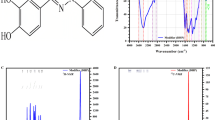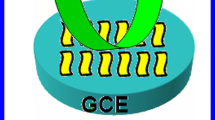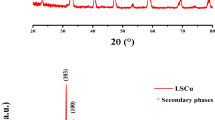Abstract
The authors describe a wax-impregnated graphite electrode modified with ferric oxide (Fe2O3) and copper hexacyanoferrate(II), and its application as an electrochemical sensor for hydroxylamine. The presence of Fe2O3 nanoparticles enhance the electron transfer kinetics and electrocatalytic activities, and also enlarge the surface area of the modified electrode. As compared to the unmodified electrode, 16.9 and 30.1 fold enhancements in amperometric response was observed for copper hexacyanoferrate(II) and the nanocomposite modified electrodes, respectively. Also, the presence of Fe2O3 in the nanocomposite enhances the anodic current response by 1.78 fold when compared to copper hexacyanoferrate(II) alone modified electrode. The electron transfer coefficient, electron transfer rate constant, diffusion coefficient and catalytic rate constant for the electro-oxidation of hydroxylamine were determined. Amperometry performed at a working voltage of 750 mV (vs. Ag/AgCl) revealed a detection range that extends from 0.8 μM to 100 μM, a detection limit of 0.5 μM (at an S/N ratio of 3) and a sensitivity of 0.0924 mA⋅mM−1. The modified electrode is remarkably stable and was successfully applied to the determination of hydroxylamine in spiked water samples.

The nanocomposite of ferric oxide and copper hexacyanoferrate(II) modified wax impregnated graphite electrode was developed for the electrochemical detection of hydroxylamine from environmental water samples. Amperometric detection at 750 mV (vs. Ag/AgCl) possessed a limit of detection of 0.5 μM.






Similar content being viewed by others
References
Arp DJ, Stein LY (2003) Metabolism of inorganic N compounds by ammonia-oxidizing bacteria. Crit Rev Biochem Mol Biol 38:471
Gross P (1985) Biologic activity of hydroxylamine: A review. Crit Rev Toxicol 14:87
Reisch M (1999) Chemical plant blast kills five near Allentown. Chem Eng News 77:11
Kumasaki M, Fujimoto Y, Ando T (2003) Calorimetric behaviours of hydroxylamine and its salts caused by Fe(III). J Loss Prev Process Ind 16:507
Li J, Lin X (2007) Electrocatalytic oxidation of hydrazine and hydroxylamine at gold nanoparticle-polypyrrole nanowire modified glassy carbon electrode. Sensors Actuators B 126:527
Afkhami A, Madrakian T, Maleki A (2006) Indirect kinetic spectrophotometric determination based on its reaction with iodate. Anal Sci 22:329
Korte WD (1992) Determination of hydroxylamine in aqueous solutions of pyridinium aldoximes by high-performance liquid chromatography with UV and fluorometric detection. J Chromatogr A 603:145
Christova R, Ivanova M, Novkirishka M (1976) Indirect potentiometric determination of arsenite, sulphite, ascorbic acid, hydrazine and hydroxylamine with an iodide-selective electrode. Anal Chim Acta 85:301
Canterford DR (1978) Polarographic determination of hydroxylamines: application to analysis of photographic processing solutions. Anal Chim Acta 98:205
Zhao C, Song J (2001) Flow-injection biamperometry for direct determination of hydroxylamine at two pretreated platinum electrodes. Anal Chim Acta 434:261
Jayasri D, Narayanan SS (2007) Amperometric determination of hydrazine at manganese hexacyanoferrate modified graphite–wax composite electrode. J Hazard Mater 144:348
Husain M, Husain Q (2007) Applications of redox mediators in the treatment of organic pollutants by using oxidoreductive enzymes: A review. Crit Rev Environ Sci Technol 38:1
Neff VD (1978) Electrochemical oxidation and reduction of thin films of prussian blue. J Electrochem Soc 125:886
Vinu Mohan AM, Gutru R, Aswini KK, Biju VM (2014) Electrocatalytic behaviour of hybrid cobalt–manganese hexacyanoferrate film on glassy carbon electrode. Thin Solid Films 565:207
Baioni AP, Vidotti M, Fiorito PA, Ponzio EA, Torresi SIC (2007) Synthesis and characterization of copper hexacyanoferrate nanoparticles for building Up long-term stability electrochromic electrodes. Langmuir 23:6796
Neff VD (1985) Some performance characteristics of a Prussian blue battery. J Electrochem Soc 132:1382
Kang YS, Risbud S, Rabolt JF, Stroeve P (1996) Synthesis and characterization of nanometer-size Fe3O4 and γ-Fe2O3 particles. Chem Mater 8:2209
Heli H, Majdi S, Sattarahmady N (2010) Fe2O3 core–NaCo[Fe(CN)6] shell nanoparticles: synthesis and characterization. Mater Res Bull 45:850
Narayanan SS, Scholz F (1999) A comparative study of the electrocatalytic activities of some metal hexacyanoferrates for the oxidation of hydrazine. Electroanalysis 11:465
Myuist RA, Kagel RO (1971) Infrared spectra of inorganic compounds. Academic Press, New York
Pauliukaite R, Ghica ME, Brett CMA (2005) A new, improved sensor for ascorbate determination at copper hexacyanoferrate modified carbon film electrodes. Anal Bioanal Chem 381:972
Shi L, Wu T, He P, Li D, Sun C, Lia J (2005) Amperometric sensor for hydroxylamine based on hybrid nickel-cobalt hexacyanoferrate modified electrode. Electroanalysis 17:2190
Gao ZN, Zhang J, Liu WY (2005) Electrocatalytic oxidation of N-acetyl-L-cysteine by acetylferrocene at glassy carbon electrode. J Electroanal Chem 580:9
Abbaspour A, Kamyabi MA (2005) Electrocatalytic oxidation of hydrazine on a carbon paste electrode modified by hybrid hexacyanoferrates of copper and cobalt films. J Electroanal Chem 576:73
Sattarahmady N, Heli H (2011) An electrocatalytic transducer for l-cysteine detection based on cobalt hexacyanoferrate nanoparticles with a core–shell structure. Anal Biochem 409:74
Zhang C, Wang G, Liu M, Feng Y, Zhang Z, Fang B (2010) A hydroxylamine electrochemical sensor based on electrodeposition of porous ZnO nanofilms onto carbon nanotubes films modified electrode. Electrochim Acta 55:2835
Ardakani MM, Karimi MA, Mirdehghan SM, Zare MM, Mazidi R (2008) Electrocatalytic determination of hydroxylamine with alizarin red S as a homogenous mediator on the glassy carbon electrode. Sensors Actuators B Chem 132:52
Lin J, Lin X (2007) Electrocatalytic oxidation of hydrazine and hydroxylamine at gold nanoparticle-polypyrrole nanowire modified glassy carbon electrode. Sensors Actuators B Chem 126:527
Lee E, Kim D, You JM, Kim SK, Yun M, Jeon S (2012) Electrocatalytic oxidation of hydrazine and hydroxylamine by graphene oxide-Pd nanoparticle-modified glassy carbon electrode. J Nanosci Nanotechnol 12:886
Zare HR, Sobhani Z, Ardakani MMM (2007) Electrocatalytic oxidation of hydroxylamine at a rutin multi-wall carbon nanotubes modified glassy carbon electrode: improvement of the catalytic activity. Sensors Actuators B Chem 126:641
Benvidi A, Kakoolaki P, Gorji AR, Ardakani MM, Zare HR, Vafazadeh R (2013) Application of Co(II) complex multi-wall carbon nanotube modified carbon paste electrodes for electrocatalytic determination of hydroxylamine. Anal Methods 5:6649
Zheng L, Song JF (2011) Electrocatalytic oxidation of hydroxylamine at Ni(II)-morin complex modified carbon nanotube paste electrode. J Appl Electrochem 41:63
Zare HR, Nasirizadeh N (2006) Electrocatalytic characteristics of hydrazine and hydroxylamine oxidation at coumestan modified carbon paste electrode. Electroanalysis 18:507
Bui NPN, Pham XH, Han KN, Li CA, Lee EK, Chang HJ, Seong GH (2010) Electrochemical sensing of hydroxylamine by gold nanoparticles on single-walled carbon nanotube films. Electrochem Commun 12:250
Zare HR, Nasirizadeh N, Ajamain H, Sahragard A (2011) Preparation, electrochemical behavior and electrocatalytic activity of chlorogenic acid multi-wall carbon nanotubes as a hydroxylamine sensor. Mater Sci Eng C Mater Biol App l31:975
Acknowledgments
Authors are grateful to Ministry of Human Resource Development and DST-FIST for the financial support.
Author information
Authors and Affiliations
Corresponding author
Electronic supplementary material
ESM 1
(PDF 199 kb)
Rights and permissions
About this article
Cite this article
Allibai Mohanan, V.M., Kacheri Kunnummal, A. & Biju, V.M.N. Electrochemical sensing of hydroxylamine using a wax impregnated graphite electrode modified with a nanocomposite consisting of ferric oxide and copper hexacyanoferrate. Microchim Acta 183, 2013–2021 (2016). https://doi.org/10.1007/s00604-016-1839-y
Received:
Accepted:
Published:
Issue Date:
DOI: https://doi.org/10.1007/s00604-016-1839-y




